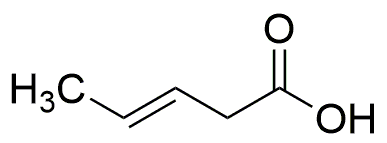trans-3-Pentenoic acid is widely utilized in research focused on:
- Flavor and Fragrance Industry: This compound is used as a flavoring agent in food products and beverages, providing a fruity note that enhances taste profiles.
- Synthesis of Pharmaceuticals: It serves as a building block in the synthesis of various pharmaceutical compounds, contributing to the development of new medications.
- Polymer Production: This acid is employed in the production of specialty polymers, which can be used in coatings, adhesives, and sealants, offering improved durability and performance.
- Biochemical Research: Researchers utilize trans-3-pentenoic acid in studies related to metabolic pathways and enzyme activity, helping to advance our understanding of biochemical processes.
- Cosmetic Formulations: It is incorporated into cosmetic products for its emulsifying properties, enhancing texture and stability in creams and lotions.
General Information
Properties
Safety and Regulations
Applications
trans-3-Pentenoic acid is widely utilized in research focused on:
- Flavor and Fragrance Industry: This compound is used as a flavoring agent in food products and beverages, providing a fruity note that enhances taste profiles.
- Synthesis of Pharmaceuticals: It serves as a building block in the synthesis of various pharmaceutical compounds, contributing to the development of new medications.
- Polymer Production: This acid is employed in the production of specialty polymers, which can be used in coatings, adhesives, and sealants, offering improved durability and performance.
- Biochemical Research: Researchers utilize trans-3-pentenoic acid in studies related to metabolic pathways and enzyme activity, helping to advance our understanding of biochemical processes.
- Cosmetic Formulations: It is incorporated into cosmetic products for its emulsifying properties, enhancing texture and stability in creams and lotions.
Documents
Safety Data Sheets (SDS)
The SDS provides comprehensive safety information on handling, storage, and disposal of the product.
Product Specification (PS)
The PS provides a comprehensive breakdown of the product’s properties, including chemical composition, physical state, purity, and storage requirements. It also details acceptable quality ranges and the product's intended applications.
Certificates of Analysis (COA)
Search for Certificates of Analysis (COA) by entering the products Lot Number. Lot and Batch Numbers can be found on a product’s label following the words ‘Lot’ or ‘Batch’.
*Catalog Number
*Lot Number
Certificates Of Origin (COO)
This COO confirms the country where the product was manufactured, and also details the materials and components used in it and whether it is derived from natural, synthetic, or other specific sources. This certificate may be required for customs, trade, and regulatory compliance.
*Catalog Number
*Lot Number
Safety Data Sheets (SDS)
The SDS provides comprehensive safety information on handling, storage, and disposal of the product.
DownloadProduct Specification (PS)
The PS provides a comprehensive breakdown of the product’s properties, including chemical composition, physical state, purity, and storage requirements. It also details acceptable quality ranges and the product's intended applications.
DownloadCertificates of Analysis (COA)
Search for Certificates of Analysis (COA) by entering the products Lot Number. Lot and Batch Numbers can be found on a product’s label following the words ‘Lot’ or ‘Batch’.
*Catalog Number
*Lot Number
Certificates Of Origin (COO)
This COO confirms the country where the product was manufactured, and also details the materials and components used in it and whether it is derived from natural, synthetic, or other specific sources. This certificate may be required for customs, trade, and regulatory compliance.

